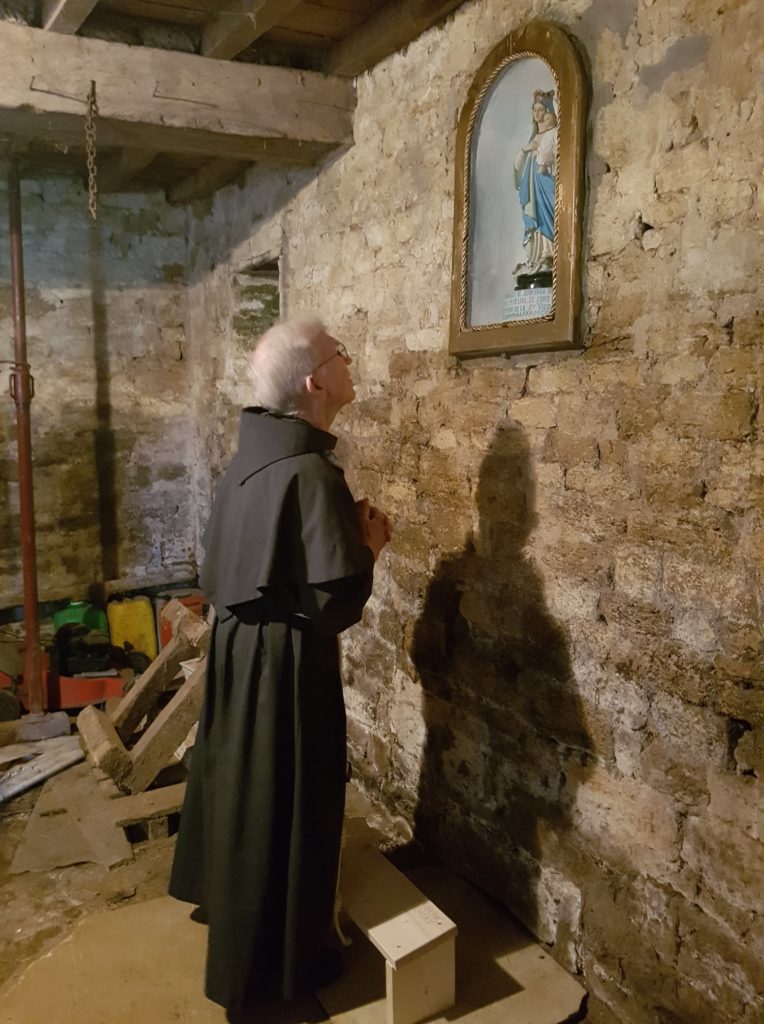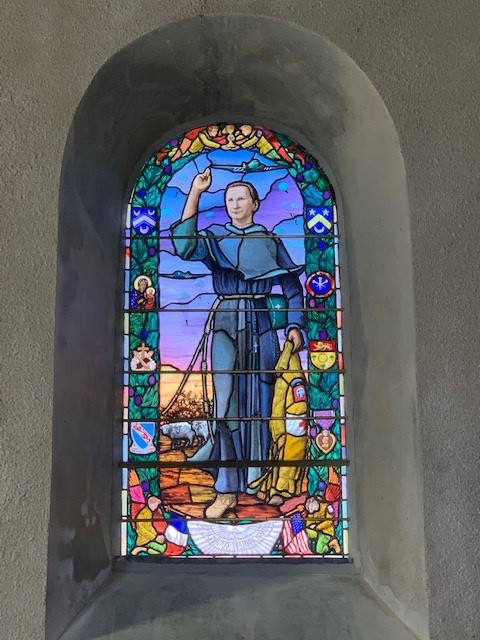
+Fr. Ignatius Maternowski vitrail (stained glass window), in La Petite Chapelle de Cauquigny, Normandy, France
While visiting the Église Saint-Ferréol of Cauquigny, to bless the new stained glass window in the chapelle des Parachutés (aka La Petite Chapelle de Cauquigny), to honor +Fr. Ignatius Maternowski, OFM Conv., our Minister Provincial – the Very Reverend Fr. James McCurry, OFM Conv. was interviewed in a live broadcast on D Day Live. Follow the link to read more about Franciscan Friar Conventual priest and US military chaplain, +Father Ignatius Maternowski, OFM Conv., who was killed during the Invasion of Normandy, France, on D-Day, June 6, 1944.
In 2019, at the 75th anniversary of D-Day, Pastor of Mother Cabrini Catholic Church (Shamokin, PA) – Fr. Martin Kobos, OFM Conv. and Province Director of Mission Advancement – Mr. Joseph Hamilton represented the Our Lady of the Angels Province (Link to Post). At that time, they presented the local US-Normandy Association of Remembrance and Gratitude (Association U.S. Normandie , mémoire et gratitude) with an American flag that had been flown over the US Capitol, in honor of +Fr. Ignatius. The Association placed this flag on the Altar at the Mass of Dedication of the +Fr. Ignatius Maternowski vitrail (stained glass window), on November 12, 2021.
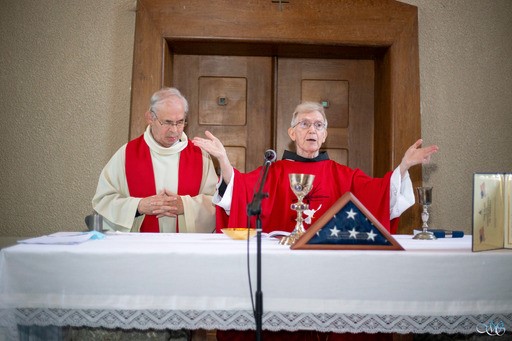 The Parish Priest of Picauville and Sainte-Mère-Église, le père Marie Bernard Seigneur (above concelebrating the November 12, 2021 Mass with Fr. James), hosted the ceremony in “La Petite Chapelle de Cauquigny,” where some of the fiercest fighting on D-Day took place – close to the nearby hamlet of Gueutteville, where Fr. Ignatius was slain.
The Parish Priest of Picauville and Sainte-Mère-Église, le père Marie Bernard Seigneur (above concelebrating the November 12, 2021 Mass with Fr. James), hosted the ceremony in “La Petite Chapelle de Cauquigny,” where some of the fiercest fighting on D-Day took place – close to the nearby hamlet of Gueutteville, where Fr. Ignatius was slain.
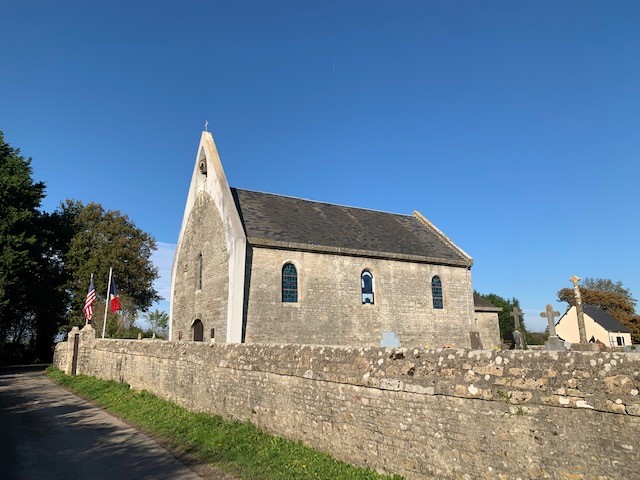
Église Saint-Ferréol Cauquigny ou Chapelle Saint-Ferréol dite chapelle des Parachutés (aka La Petite Chapelle de Cauquigny)
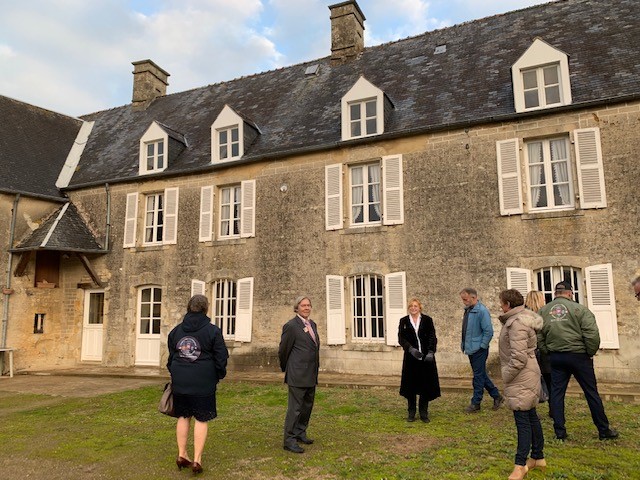
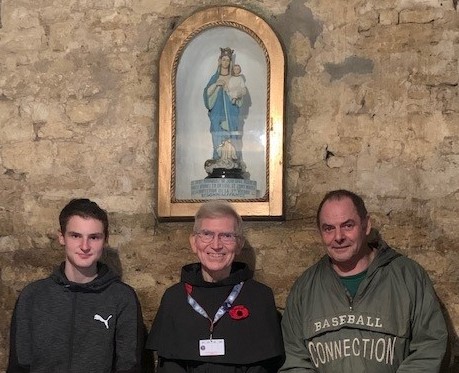 As the fighting raged on D-Day and the following week around Gueutteville, Normandy, the body of our slain friar-priest-chaplain lay off limits on the hamlet’s single dirt road where he died. Local survivors with their children took refuge in this dwelling that the Germans had occupied, and where Fr. Ignatius had tried to persuade the enemy to observe the Geneva conventions which protected the civilians and the wounded troops. After the war, the hamlet’s survivors pooled their scant money to obtain and install at the site this statue of the Blessed Virgin Mary (below). Its present owner – Claude and his son – Remy (at right with Fr. James) welcomed the group to pray before the treasured statue.
As the fighting raged on D-Day and the following week around Gueutteville, Normandy, the body of our slain friar-priest-chaplain lay off limits on the hamlet’s single dirt road where he died. Local survivors with their children took refuge in this dwelling that the Germans had occupied, and where Fr. Ignatius had tried to persuade the enemy to observe the Geneva conventions which protected the civilians and the wounded troops. After the war, the hamlet’s survivors pooled their scant money to obtain and install at the site this statue of the Blessed Virgin Mary (below). Its present owner – Claude and his son – Remy (at right with Fr. James) welcomed the group to pray before the treasured statue.
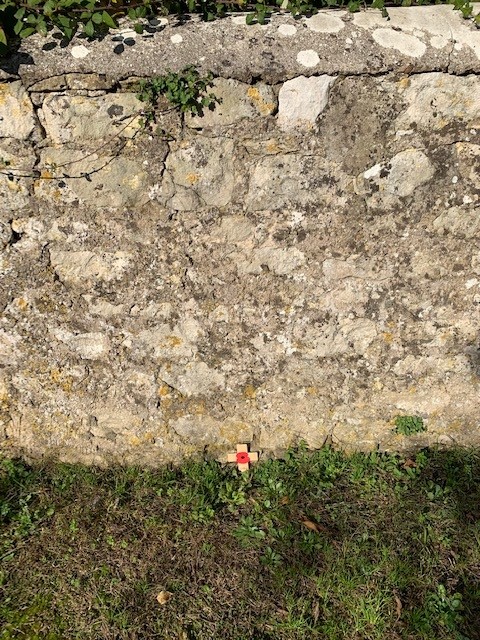
Fr. James left a cross with a red poppy, at the old stone wall on Gueutteville’s sole street, at the exact spot where Fr. Ignatius’ slain body lay unmoved for three days.
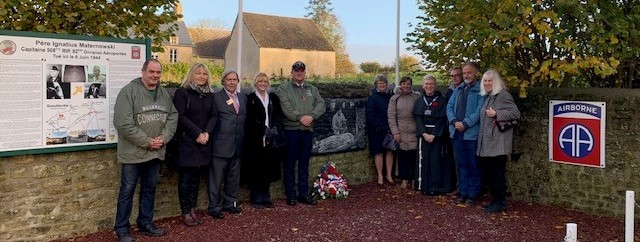
The group visited the Memorial in Guetteville, France, commemorating the charity and heroism of Franciscan Friar Conventual Fr. Ignatius Maternowski on D-Day, June 6, 1944.
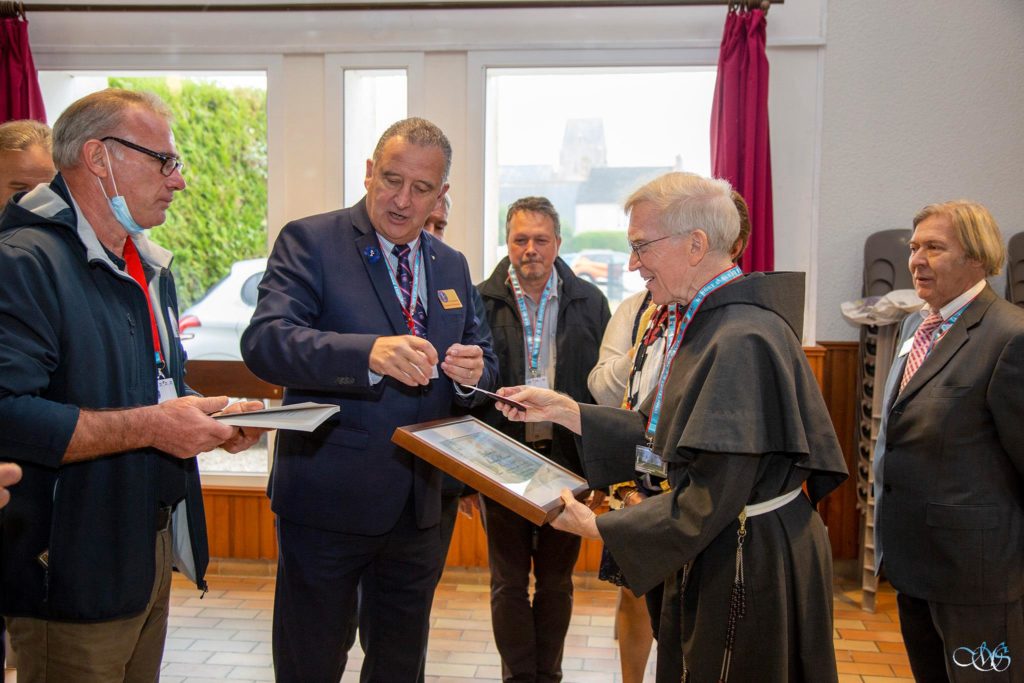
On the day that Fr. James blessed the new Fr. Ignatius Window in Normandy’s Cauquigny Chapel, L’association US Normandie Mémoire et Gratitude conferred upon Fr. James honorary membership in the Association.
For more photos and a video of the speech
by L’Association Président: Eric Labourdette,
visit Association U.S. Normandie , mémoire et gratitude.
_______________________________
Bénédiction du vitrail
en l’honneur de
+Père Ignatius Maternowski, OFM Conv.
Cauquigny, Normandie, France
12 novembre 2021
Homélie prononcée par Fr. James McCurry, OFM Conv.
Les premiers frères franciscains sont arrivés en Normandie à pied au treizième siècle, du vivant de leur fondateur, Saint François d’Assise. Plus de sept cent cinquante ans plus tard, un autre frère franciscain est arrivé en Normandie, non pas à pied mais en parachute. Le Père Ignatius Maternowski, prêtre et aumônier franciscain, est arrivé ici à Amfreville, Picauville, Guetteville et Cauquigny, le 6 juin 1944 – le Jour J. Peut-être certains de vos propres parents et grands-parents l’ont-ils accueilli, lui et ses compagnons d’armes, en ce jour fatidique, alors que commençait leur mission de libération de la France.
Le père Ignatius a versé son sang ici, sur le sol de Normandie, quelques heures après son arrivée. Il a été le seul aumônier américain à mourir le jour J. Il a offert sa vie pour vous, à l’âge de trente-deux ans, en tant que martyr pour la cause des droits de l’homme. Sa mort a témoigné du passage de l’Évangile : “Celui qui perdra sa vie [pour les saints desseins de Dieu] la sauvera” [cf. Luc 17:33]. Peut-être qu’un jour, l’Église catholique déclarera le père Ignace “bienheureux”, puis “saint”. Aujourd’hui, pour vous et pour moi, le Père Ignace est déjà considéré comme un “saint” homme de Dieu, dont nous invoquons la mémoire avec honneur, dévotion, gratitude et prière.
La Normandie a toujours été un lieu qui manifeste la gloire de Dieu. Comme le dit le Livre de la Sagesse, le vent, l’air, la mer, les étoiles – tous si évidents en Normandie – évoquent la puissance et l’énergie de notre Dieu Créateur – un Dieu d’Amour en qui le Père Ignace a trouvé toute l’inspiration et le courage dont il avait besoin pour venir ici le Jour J.
Ce magnifique nouveau vitrail dans la chapelle de Cauquigny nous rappellera à jamais que l’amour héroïque est possible – l’amour du pays, l’amour de l’humanité, l’amour de Dieu. L’artiste du vitrail, M. Joseph Beyer, de Philadelphie, en Pennsylvanie, aux États-Unis, a représenté le père Ignace comme un héros de l’amour – portant l’habit gris de l’ordre franciscain, et arborant l’uniforme de la quatre-vingt-deuxième division aéroportée. En réalité, le père Ignace était un homme qui portait trois uniformes différents – chacun distinct : son habit franciscain, ses vêtements sacerdotaux et sa tenue de combat de soldat.
Le père Ignace avait trois identités distinctes – frère, prêtre et aumônier de l’armée. Il est mort en portant l’uniforme de la quatre-vingt-deuxième division aéroportée de l’armée des États-Unis. Cependant, il ne portait que l’uniforme d’aumônier, car il avait d’abord été appelé à porter l’uniforme de l’ordre franciscain et les vêtements du sacerdoce. Il portait des vêtements différents pour manifester ses différentes identités à des communautés particulières, mais ces trois uniformes signifiaient tous un message commun : L’amour chrétien du père Ignace pour tous les peuples et son engagement à défendre la dignité de chaque personne humaine.
Lorsque le Père Ignace a été abattu à Guetteville, il portait un brassard à croix rouge pour rappeler les conventions de Genève en vigueur depuis 1929, des dispositions destinées à protéger en temps de guerre tous les blessés, les mourants et les non-combattants. Le témoignage de M. Theroude a clairement montré que le Père Ignace a risqué sa vie pour persuader l’ennemi de ces principes de droits de l’homme et pour protéger les populations locales de cette région. Le père Ignace est mort pour protéger, non seulement ses compagnons d’armes blessés, mais aussi tous les innocents non-combattants de la région contre les représailles allemandes. Il est mort pour défendre ces principes – un martyr de l’amour.
Même aujourd’hui, à une époque séculaire et pluraliste, ce capitaine de l’armée catholique et franciscaine – un simple garçon de la petite ville de Holyoke, dans le Massachusetts – incarne les aspirations les plus élevées de toutes les branches de la famille humaine. Son engagement envers la dignité de la personne humaine était absolu. Aujourd’hui, grâce à ce nouveau vitrail, chaque personne qui entre dans la chapelle de Cauquigny peut contempler ces vérités. Chaque visiteur peut quitter cette chapelle inspiré par la conviction que l’amour pour l’humanité ne doit connaître aucune limite, comme en témoignent la vie et la mort du Père Ignace.
Permettez-moi de conclure en reconnaissant et en remerciant, au nom de la famille franciscaine du père Ignace, tous ceux qui ont rendu possible la célébration et la cérémonie de bénédiction d’aujourd’hui :
- Père Seigneur, curé de Sainte-Mère Eglise
- Maire d’Amfreville, Madame Ginette Dongé
- Maire de Picauville, Madame Marie Hélène Perrotte
- Maire de Sainte-Mère Eglise, Alain Holley
- Maire de Beuzeville la Bastille, Carles Dupont
- Sénateur Philippe Lebas
- le député Philippe Gosselin
- Les membres de l’Association US-Normandie ‘Memorie et Gratitude’,
- notamment :
- M. Pascal Millet
- M.Emile LaPierre
- M. Daniel Briard
- M. Eric Labourdette
- M. Steve Todd
- Mme Vivian Roger et M. Rodolphe Roger
- La colonel Kelly Carrigg
- M. Joseph Beyer et son épouse Rita
Enfin, permettez-moi de remercier tous ceux qui sont ici aujourd’hui – les habitants de Normandie qui chérissent la mémoire de mon frère franciscain, le Père Ignace. Je ne peux imaginer un plus bel endroit au monde où la mémoire de ce gentil héros-martyr devrait être préservée et vénérée. Que Dieu vous bénisse.
[English Translation]
Blessing of Stained-Glass Window
in honor of
+Father Ignatius Maternowski, OFM Conv.
Cauquigny, Normandy, France
12th November 2021
Homily delivered by Fr. James McCurry, OFM Conv.
The first Franciscan friars came to Normandy by foot in the thirteenth century, during the lifetime of their founder, St. Francis of Assisi. Over seven hundred and fifty years later, another Franciscan Friar arrived in Normandy, not by foot but by parachute. Father Ignatius Maternowski, a Franciscan priest and chaplain, came here to Amfreville, Picauville, Guetteville and Cauquigny, on the 6th of June 1944 – D-Day. Perhaps some of your own parents and grandparents welcomed him and his fellow soldiers on that fateful day, as their mission to liberate France began.
Father Ignatius shed his blood here in the soil of Normandy a few hours after he arrived. He was the only American chaplain who died on D-Day. He offered his life for you, at the age of thirty-two years, as a martyr for the cause of human rights. His death gave testimony to the Gospel passage: “Whoever loses his life [for God’s holy purposes] will save it” [cf. Luke 17:33]. Perhaps someday, the Catholic Church will declare Father Ignatius a “blessed,” and eventually a “saint.” Now, for you and for me, Father Ignatius is already regarded as a “holy” man of God, whose memory we invoke with honor, devotion, gratitude, and prayer.
Normandy has always been a place which manifests the glory of God. As the Book of Wisdom tells us – the wind, the air, the sea, the stars – all so evident in Normandy – bespeak the might and energy of our Creator God – a God of Love in whom Father Ignatius found all the inspiration and courage he needed to come here on D-Day.
This beautiful new stained-glass window in the Chapel of Cauquigny will forever remind us that heroic love is possible – love of country, love of humanity, love of God. The artist of the window, Mr. Joseph Beyer of Philadelphia, Pennsylvania, in the United States, has depicted Father Ignatius as a hero of love – wearing the grey habit of the Franciscan Order, and displaying the uniform of the eighty-second airborne division. Actually, Father Ignatius was a man who wore three different uniforms – each distinct: his Franciscan robes, his priestly vestments, and his soldier’s battle dress.
Father Ignatius had three distinct identities – friar, priest, and army chaplain. He died wearing the uniform of the eighty-second airborne division of the army of the United States. However, he only wore the uniform of a chaplain, because he had first been called to wear the uniform of the Franciscan Order and the vestments of the Priesthood. He wore different clothes to manifest his different identities to particular communities, but all three of these uniforms signified one common message: Father Ignatius’s Christian love for all people, and his commitment to defend the dignity of every human person.
When Father Ignatius was shot to death in Gueutteville, he wore a red cross armband to signify the Geneva conventions which were in effect since 1929, provisions designed to protect in wartime all the wounded, the dying, and the non-combatants. The eyewitness testimony of Mr. Theroude has made it clear that Father Ignatius risked his life to persuade the enemy about those principles of human rights, and to keep safe the local people of this region. Father Ignatius died to protect, not only his wounded fellow soldiers, but to safeguard all the innocent non-combatants of the area from the German reprisals. He died in defense of those principles – a martyr of love.
Even now, in a secular and pluralistic age, this Catholic, Franciscan, Army captain – a simple boy from the small town of Holyoke, Massachusetts – embodies the very highest aspirations of any branch of the human family. His commitment to the dignity of the human person was absolute. Now, because of this new stained-glass window, every person walking into Cauquigny Chapel can contemplate these truths. Every visitor can leave this chapel inspired by the conviction that love for humanity must know no limits, as evidenced by the life and death of Father Ignatius.
Permit me to conclude by acknowledging and thanking, on behalf of Father Ignatius’s Franciscan family, all of those who have made possible today’s celebration and benediction ceremony:
- Father Seigneur, pastor of Sainte-Mere Eglise
- Mayor of Amfreville, Madame Ginette Dongé
- Mayor of Picauville, Madame Marie Hélène Perrotte
- Mayor of Sainte Mere Eglise, Alain Holley
- Mayor of Beuzeville la Bastille, Carles Dupont
- Senator Philippe Lebas
- Deputy Philippe Gosselin
- Members of the US-Normandy Association ‘Remembrance and Gratitude’, especially:
- Mr. Pascal Millet
- Mr. Emile LaPierre
- Mr. Daniel Briard
- Mr. Eric Labourdette
- Mr. Steve Todd
- Vivian Roger and Mr. Rodolphe Roger
- Colonel Kelly Carrigg
- Joseph Beyer and his wife Rita
Finally, permit me to thank all of you who are here today – the people of Normandy who cherish the memory of my Franciscan brother, Father Ignatius. I can think of no more beautiful place in the world where the memory of this gentle hero-martyr should be preserved and revered. May God bless you.

